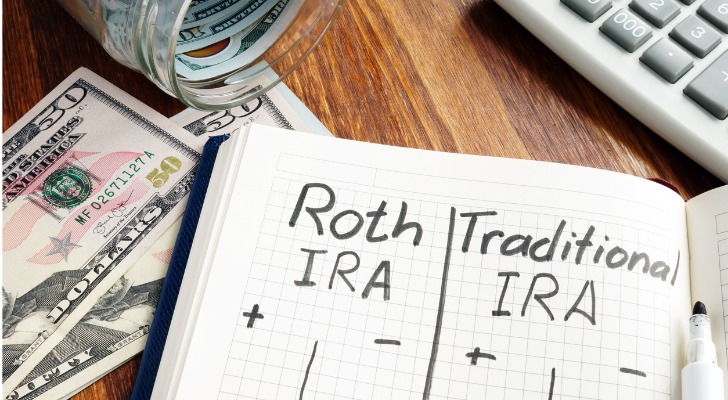Individual retirement accounts (IRAs) are one of the most popular ways to save for retirement. Traditional IRAs provide tax deductions on your contributions, effectively reducing your current taxable income. In contrast, Roth IRAs are funded with after-tax dollars, allowing for tax-free withdrawals during retirement. The Internal Revenue Service (IRS) permits you to contribute to both a traditional and Roth IRA in the same year, so long as your contributions don’t exceed the defined limit within the year.
A financial advisor can help pick investments and plan for retirement. Find a fiduciary advisor today.
IRA Contribution Rules
Having a clear understanding of the contribution rules for both types of IRAs plays a crucial role in making the most of their benefits.
First and foremost, you must have earned income to be eligible to contribute to either type of IRA. Earned income may include wages, salaries, tips, bonuses or even alimony if it’s taxable to you. Passive sources like rental income, interest and dividends won’t qualify you for an IRA.
IRAs are also subject to annual contribution limits set by the IRS. In 2026, the total contribution limit across both traditional and Roth IRAs is $7,500 for individuals under age 50, and $8,600 for those 50 and older, regardless of how the contributions are divided between the two IRAs. However, contributing more than the allowable limit to your IRA can result in penalties. It’s essential to monitor your contributions to avoid this.
2025 and 2026 IRA Contribution Limits
| Contribution Type | 2025 | 2026 |
|---|---|---|
| Annual Contribution | $7,000 | $7,500 |
| Catch-up Contribution | $1,000 | $1,100 |
| Total Contribution | $8,000 | $8,600 |
Unlike traditional IRAs, Roth IRAs have specific income limits that determine whether you can make direct contributions. These limits vary based on your filing status. If your income exceeds these ceilings, you may still be able to use a backdoor Roth IRA strategy.
Lastly, you have until Tax Day each year to make IRA contributions for the previous tax year.
Eligibility for Traditional IRAs

While there currently is no age limit to contributing to a traditional IRA, this hasn’t always been the case. Previously, you became ineligible for a traditional IRA at age 70 ½, but this age limit no longer applies. Traditional IRAs are, however, subject to required minimum distributions (RMDs). This means you must begin withdrawing from your account at age 73, or 75 if you were born in 1960 or later.
Traditional IRA Deduction Limits
The contributions to a traditional IRA are usually tax-deductible for the tax year they are made, which can decrease your annual tax liability. However, if you or your spouse is covered by a workplace retirement plan like a 401(k), the amount you can deduct for your traditional IRA contributions may be limited based on your modified adjusted gross income (MAGI).
If you are single or the head of your household and have a workplace retirement plan in 2026, your traditional IRA contribution is:
- Fully deductible if your MAGI is $81,000 or less
- Partially deductible if your MAGI is more than $81,000 and less than $91,000
- Non-deductible if your MAGI is $91,000 or higher
If you are married, file jointly and have a workplace retirement plan in 2026, your traditional IRA contribution is:
- Fully deductible if your MAGI is $129,000 or less
- Partially deductible if your MAGI is more than $129,000 and less than $149,000
- Non-deductible if your MAGI is $149,000 or higher
If you are married, file jointly and have a spouse with a workplace plan in 2026 – but you do not – IRA contributions are:
- Fully deductible if your MAGI is $242,000 or less
- Partially deductible if your MAGI is more than $242,000 and less than $252,000
- Non-deductible if your MAGI is $252,000 or higher
Eligibility for Roth IRAs
Like a traditional IRA, you must have earned income in order to contribute to a Roth IRA. Additionally, your income must fall within certain ranges, which are set by the IRS and can change annually.
For single filers, heads of households and married couples who file separately (but do not live together), the income limits for Roth IRA eligibility in 2026 are as follows:
- You can make a full contribution if your MAGI is less than $153,000
- You can make a partial contribution if your MAGI is more than $153,000 and less than $168,000
- You are no longer eligible to contribute to a Roth IRA if your MAGI is $168,000 or above
For married couples filing jointly, the income limits for Roth IRA eligibility in 2026 are as follows:
- You can make a full Roth contribution if your MAGI is less than $242,000
- You can make a partial contribution if your MAGI is between $242,000 and $252,000
- You are no longer eligible to contribute to your Roth IRA if your MAGI is $252,000 or higher
How to Divide Your Contributions

If you’re in a higher tax bracket now and expect to be in a lower one during retirement, a traditional IRA may offer more immediate tax savings. Conversely, if you anticipate being in a higher tax bracket later, a Roth IRA might be more advantageous since your withdrawals will be tax-free.
However, not everyone has a clear picture of what their tax situation will be in retirement. As a result, you may consider dividing your contributions between a traditional and Roth IRA.
One approach could involve contributing to a traditional IRA up to the point where your taxable income falls to a lower bracket. You could then divert the remaining amount to your Roth IRA. This tactic offers immediate tax savings while also securing future tax-free income.
For example, a 35-year-old could potentially divide her $7,500 contribution by investing $3,750 in a traditional IRA for the tax deduction and the remaining $3,750 in a Roth IRA.
In deciding how to divide your contributions, keep in mind that Roth IRAs also have potential estate planning benefits. Since they aren’t subject to RMDs, you can pass on your Roth IRA to heirs tax-free, potentially creating a lasting legacy.
Choosing Which IRA to Invest the Most Money
The decision on which IRA to prioritize requires careful consideration of several factors. These can range from your current tax rate, expected tax rate in retirement, basic eligibility and the importance of future tax savings vs. current tax savings.
The optimal choice can differ based on your financial situation. For instance, a young worker in a low tax bracket might lean toward Roth IRA contributions for tax-free income during retirement. Conversely, a high-income worker could favor traditional IRA contributions to benefit from immediate tax reductions. With so many factors to consider, the aid of a financial advisor can be invaluable in evaluating current and future tax rates as well as retirement expectations to align personal financial goals.
Bottom Line
Understanding the rules that govern IRAs and strategically distributing your contributions across traditional and Roth IRAs can potentially improve your financial stability in retirement. Identifying which account to prioritize based on your unique circumstances can help you maximize the potential of your retirement savings.
Retirement Planning Tips
- Do you know how much money you need to retire? SmartAsset’s retirement calculator can help you estimate your magic number.
- A financial advisor can help you manage your retirement accounts and plan for your golden years. Finding a financial advisor doesn’t have to be hard. SmartAsset’s free tool matches you with vetted financial advisors who serve your area, and you can have a free introductory call with your advisor matches to decide which one you feel is right for you. If you’re ready to find an advisor who can help you achieve your financial goals, get started now.
Photo credit: ©iStock.com/designer491, ©iStock.com/kupicoo, ©iStock.com/Fly View Productions
